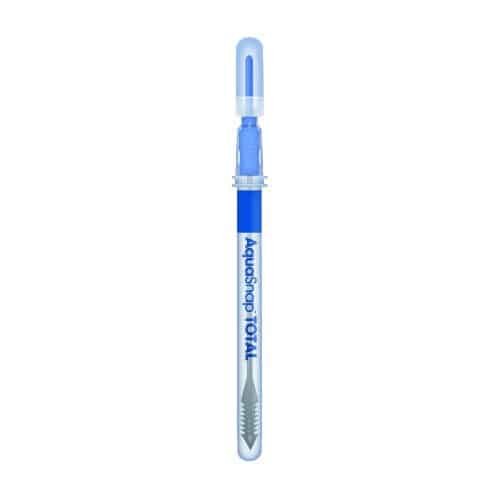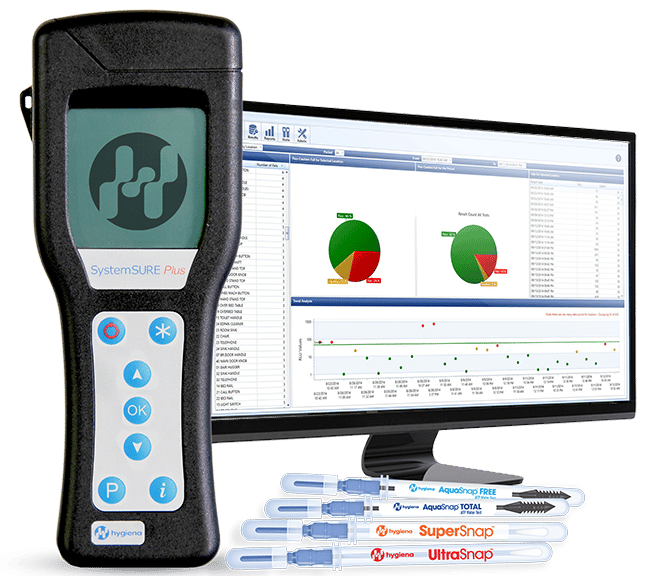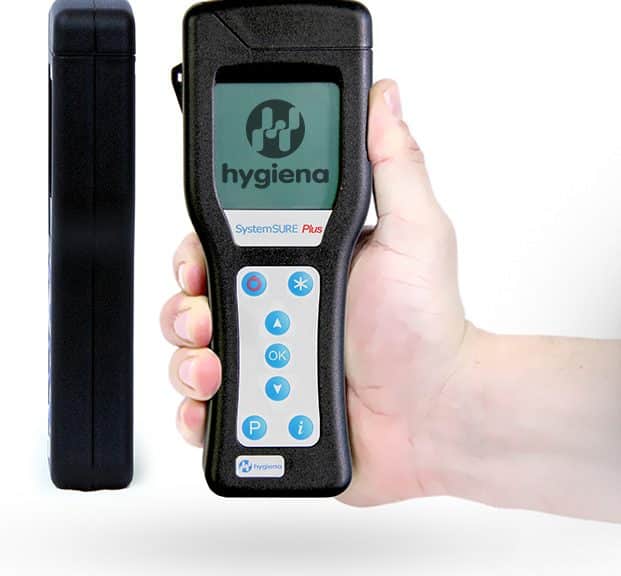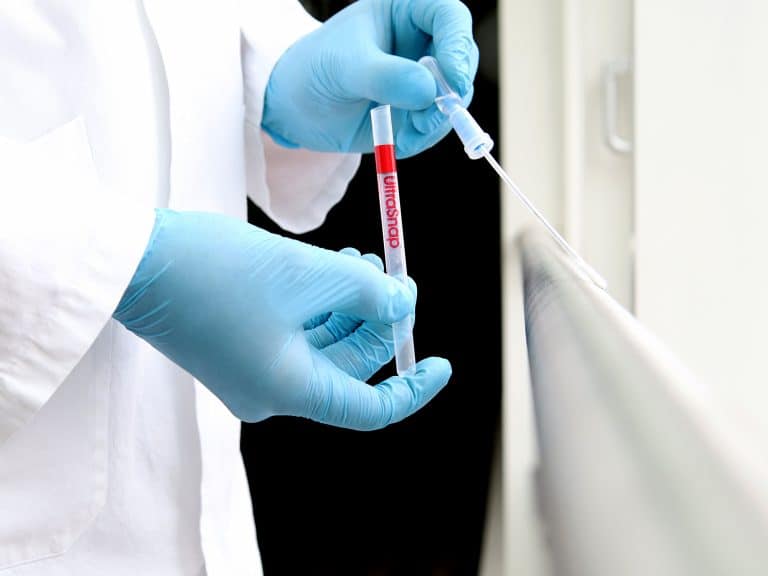The Hygiena AquaSnap- Hygiena offers a diverse range of ATP testing devices and swabs to ensure that cleaning processes are correctly undertaken in various facilities.
Working in partnership since 2004, Sychem and Hygiena supply a variety of swabs for both surface and solution-based tests.
What is an ATP Hygiene Monitoring test?
ATP Hygiene Monitoring is used to test for the presence of Adenosine Triphosphate, more commonly known as ATP, on surfaces or within solutions.
ATP is an energy molecule that is found in all living cells, that allows cellular metabolism to take place.
An ATP test is used to assess the performance of a cleaning process beyond visible means, providing a scientific measure of total cleanliness. It provides a quantitative reading on how well a cleaning process has been performed.
The data from the reading is then used to monitor the hygiene performance over time and can be used to highlight areas that could be improved. The result is the continuous improvement of a cleaning process and, therefore, overall hygiene.
AquaSnap Free and AquaSnap Total
Hygiena’s AquaSnap ™ water testing devices are self-contained ATP tests, designed for use with Hygiena luminometers. The devices are used to monitor ATP levels in water, as a quality indicator in areas such as Clean-InPlace (CIP) systems, and rinse water samples. The test is also used for water treatment applicators in the healthcare industry, and monitoring biomass in cooling towers.
AquaSnap™ Total measures both microbial ATP (living cells and particulate) within solution, and Free ATP dissolved in water (non-microbial or dead cells). The swab contains a detergent to release ATP that is bound to microbial or organic matter and inside microbes.
The Hygiena AquaSnap is easy to use, economical and gives real-time results. The dipper tip was explicitly designed and collects 100 µl of water, ensuring the consistent collection of a sample.
AquaSnap Free™ only measures dissolved ATP outside of living cells (non-microbial ATP).
When used together, AquaSnap™ Total and AquaSnap™ Free can be an effective quality monitoring system for the presence of ATP within a solution.
Users are advised to use AquaSnap Total in combination with AquaSnap Free to determine microbial ATP in a water sample. Firstly, test a water sample using an AquaSnap™ Total swab, which will give you the total load, and record the number provided by the result.
Then, test the same water sample using the AquaSnap™ Free, which will provide you with the total of Free ATP, and record the number.
The difference between the Total and Free test results provides users with an indication of the microbial contamination within the sample.
How to use AquaSnap?
To use AquaSnap to test ATP levels, users must follow the steps below (as per Hygiena’s instructions).
1. Allow AquaSnap™ test devices to equilibrate to room temperature (21-25°C) before use. Forcefully flick the device in a downward motion to shake the liquid extractant from the collection dipper to the bottom of the tube.
Shaking the liquid extractant to the bottom of the tube assists with accurate extraction of ATP, and helps collect a more consistent sample. Firmly hold the swab tube, twist and pull the collection device out of the tube. Submerge sample collection dipper in a water sample for 1-2 seconds.
2. Lift the sample collection device up vertically, and reinsert it into the test tube. Gently shake the device for 1-2 seconds to release the water sample from the collection tip and mix the sample with extractant at the bottom of the test tube.
3. Activate AquaSnap™ by holding the tube firmly and using thumb and forefinger to break Snap Valve™ by bending the bulb forward and backwards. Squeeze bulb twice, expelling all liquid into the tube.
4. Shake for 3-5 seconds to mix the sample.
5. Insert the entire AquaSnap™ device into the Hygiena luminometer, close the lid and press “OK” to initiate measurements. The result should be measured within 15 seconds of activation.
6. Hygiena recommends setting RLU thresholds according to the user’s test application. Higher RLU results indicate higher contamination in the sample. In clean or treated water samples, Free ATP results are similar to Total ATP results.
In some circumstances, when organic matter is present and where microbial contamination is low, Total ATP results may appear lower than Free ATP results; this is normal and is due to the presence of extractant in AquaSnap™ Total.
To learn more about our range of Hygiena ATP testing devices and swabs, visit our ATP Hygiene Monitoring page or to discover their complete portfolio, visit the Hygiena webpage for more information.












